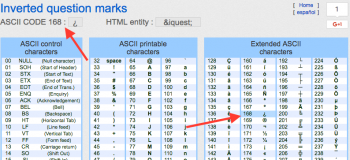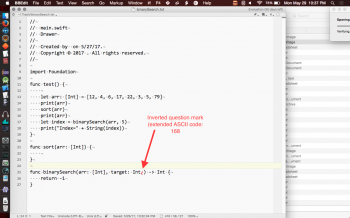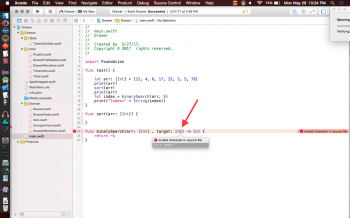Gracias, Senor. I did exactly what you suggested, and I've found out what that character is. Please see the attached images (3 images) and main.swift file (renamed as SwiftCode.txt, and containing the offending character).
Thanks for posting all that. You misinterpreted a few things, so I'll post my analysis first, then go into those mistakes.
First, here's a hex dump of the file you uploaded.
Code:
hexdump -C /Volumes/Browser/Browser-downloads/SwiftCode.txt
00000000 2f 2f 0a 2f 2f 20 20 6d 61 69 6e 2e 73 77 69 66 |//.// main.swif|
00000010 74 0a 2f 2f 20 20 44 72 61 77 65 72 0a 2f 2f 0a |t.// Drawer.//.|
00000020 2f 2f 20 20 43 72 65 61 74 65 64 20 62 79 20 20 |// Created by |
00000030 35 2f 32 37 2f 31 37 2e 0a 2f 2f 20 20 43 6f 70 |5/27/17..// Cop|
00000040 79 72 69 67 68 74 20 c2 a9 20 32 30 31 37 20 20 |yright .. 2017 |
00000050 72 69 67 68 74 73 20 72 65 73 65 72 76 65 64 2e |rights reserved.|
00000060 0a 2f 2f 0a 0a 69 6d 70 6f 72 74 20 46 6f 75 6e |.//..import Foun|
00000070 64 61 74 69 6f 6e 0a 0a 66 75 6e 63 20 74 65 73 |dation..func tes|
00000080 74 28 29 20 7b 0a 20 20 20 20 0a 20 20 20 20 6c |t() {. . l|
00000090 65 74 20 61 72 72 3a 20 5b 49 6e 74 5d 20 3d 20 |et arr: [Int] = |
000000a0 5b 31 32 2c 20 34 2c 20 36 2c 20 31 37 2c 20 32 |[12, 4, 6, 17, 2|
000000b0 32 2c 20 33 2c 20 35 2c 20 37 39 5d 0a 20 20 20 |2, 3, 5, 79]. |
000000c0 20 70 72 69 6e 74 28 61 72 72 29 0a 20 20 20 20 | print(arr). |
000000d0 73 6f 72 74 28 61 72 72 29 0a 20 20 20 20 70 72 |sort(arr). pr|
000000e0 69 6e 74 28 61 72 72 29 0a 20 20 20 20 6c 65 74 |int(arr). let|
000000f0 20 69 6e 64 65 78 20 3d 20 62 69 6e 61 72 79 53 | index = binaryS|
00000100 65 61 72 63 68 28 61 72 72 2c 20 35 29 0a 20 20 |earch(arr, 5). |
00000110 20 20 70 72 69 6e 74 28 22 49 6e 64 65 78 3d 22 | print("Index="|
00000120 20 2b 20 53 74 72 69 6e 67 28 69 6e 64 65 78 29 | + String(index)|
00000130 29 0a 7d 0a 0a 66 75 6e 63 20 73 6f 72 74 28 61 |).}..func sort(a|
00000140 72 72 3a 20 5b 49 6e 74 5d 29 20 7b 0a 20 20 20 |rr: [Int]) {. |
00000150 20 0a 7d 0a 0a 66 75 6e 63 20 62 69 6e 61 72 79 | .}..func binary|
00000160 53 65 61 72 63 68 28 61 72 72 3a 20 5b 49 6e 74 |Search(arr: [Int|
00000170 5d 2c 20 74 61 72 67 65 74 3a 20 49 6e 74 1b 29 |], target: Int.)|
00000180 20 2d 3e 20 49 6e 74 20 7b 0a 20 20 20 20 72 65 | -> Int {. re|
00000190 74 75 72 6e 20 2d 31 0a 7d |turn -1.}|
00000199
The first line shown is the Terminal command line. The pathname refers to the file in its location on my machine. Yours will be in a different place on your machine.
You can replicate this hex dump by typing
hexdump -C followed by a space, then dragging the file you want dumped over the Terminal window and dropping it. Terminal will fill in the path name. Then press RETURN in the Terminal window. Voila.
The line where the Xcode error occurs is the one that starts
00000170. The character between
Int and
) is the offending character. It happens to be 0x1b, not the "inverted question mark" you noted.
0x1b is an ESC character, which isn't something one would usually type by accident. However, if you're using the Touch Bar Macbook Pro, maybe you're accidentally touching the ESC icon.
I can't even type ESC in my Xcode here, because it's bound to a symbol-matching popup action using Xcode's key bindings. You should probably check whether you've got a key binding for ESC, and if not, at least bind it to some action so it doesn't get inserted into the text.
I completely forgot that Xcode is capable of showing space characters. It should be one of the menu items under its Editor menu. Look for something like "Show Spaces" or "Show Whitespace", although it may be called "Show Invisibles".
You haven't told us which Xcode or OS version you're using, so knowing that may help us give you better info about how to do things in Xcode.
Your interpretation of what the offending character is went wrong in two ways.
First, BBEdit doesn't actually show characters that have no displayable glyph. If it did that, then the centered dot wouldn't be shown for SPACE, and
¬ wouldn't be shown for NEWLINE. Instead, it shows proxies for invisible characters, and draws them in gray so you can distinguish an invisible from a literal visible character You incorrectly concluded that just because BBEdit shows a
¿ for an invisible character, that the code in the file is for that character.
Second, you used the wrong character encoding table for deciphering what the code for ¿ should be. BBEdit tells us that the file is being interpreted as UTF-8 Unicode (see its status bar at bottom), so the "extended ASCII" table simply isn't relevant.
You can even confirm that BBEdit is telling us the truth about UTF-8 by looking at this line in the hex dump:
Code:
00000040 79 72 69 67 68 74 20 c2 a9 20 32 30 31 37 20 20 |yright .. 2017 |
The sequence
c2 a9 is the © symbol represented as two
UTF-8 bytes. You can manually write out the bits and form them into a full Unicode code-point, and confirm it's the © symbol.
If I were still teaching programming classes, I'd give an assignment at this point to write a program that scans an input file for any bytes not in the range of 0x20-0x7E, and displays them in a unique and visible way. Control characters 0x00-0x1F should appear as ^ followed by the non-control code (e.g. 0x01 would show "^A"). Newlines produce both the "^J" form and a newline. Bytes 0x7F-0xFF should appear as "\xXY" where the "\x" is literal, and XY is the hex representation of the byte. All other characters appear as themselves on output. The program should read from stdin and write to stdout. This assignment is worth 10 points.




